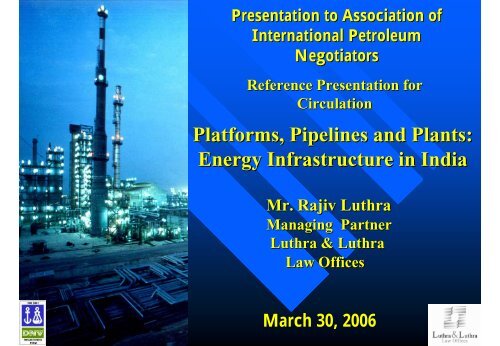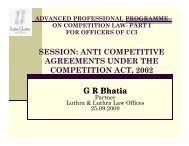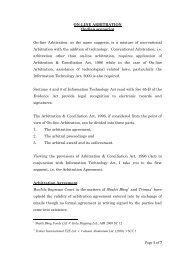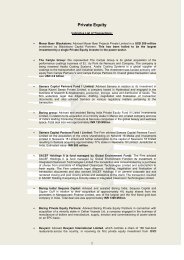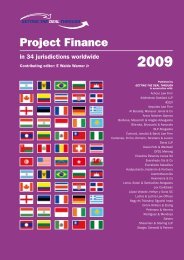Presentation - Luthra & Luthra
Presentation - Luthra & Luthra
Presentation - Luthra & Luthra
Create successful ePaper yourself
Turn your PDF publications into a flip-book with our unique Google optimized e-Paper software.
<strong>Presentation</strong> to Association of<br />
International Petroleum<br />
Negotiators<br />
Reference <strong>Presentation</strong> for<br />
Circulation<br />
Platforms, Pipelines and Plants:<br />
Energy Infrastructure in India<br />
Mr. Rajiv <strong>Luthra</strong><br />
Managing Partner<br />
<strong>Luthra</strong> & <strong>Luthra</strong><br />
Law Offices<br />
March 30, 2006<br />
1
Some Questions…<br />
! Locating India<br />
! Oil and Gas Supply and Demand<br />
! Present and Future Energy Needs<br />
! Present Infrastructure and the Scenario of Deficit<br />
! Meeting the Demand: Exploring the Options<br />
! A Few Issues<br />
! Proposed Expansion and Evolving Regulations<br />
! A Vision for the Future<br />
! Why India<br />
2
Locating India……<br />
One of the lowest per capita energy consumption in the world-<br />
479Kgoe<br />
Accounts for 5% of total world demand and 5 th in terms of<br />
energy consumption<br />
3
Oil & Gas Supply<br />
100<br />
90<br />
80<br />
78.71<br />
OIL SUPPLY (MMT)<br />
81.99<br />
90.43<br />
95.86<br />
100<br />
90<br />
80<br />
GAS SUPPLY (MMT)<br />
70<br />
70<br />
60<br />
60<br />
50<br />
50<br />
40<br />
30<br />
14<br />
40<br />
30<br />
23 24 24<br />
20<br />
10<br />
0<br />
32.03 33.04 33.37 33.98<br />
2001-02 2002-03 2003-04 2004-05<br />
20<br />
10<br />
0<br />
10<br />
2001-02 2002-03 2003-04 2004-05<br />
Domestic<br />
Imports<br />
! India a net energy importer, currently imports ~70% of oil, 20% of gas<br />
consumption<br />
! Domestic oil & gas production stagnant since 2000-01. 01. Decline attributable<br />
to maturing field<br />
! Domestic gas new discoveries and imports to play significant role e in<br />
Country’s s energy security<br />
4
Oil & Gas – Demand<br />
400<br />
350<br />
OIL DEMAND (MMT)<br />
364<br />
400<br />
350<br />
GAS DEMAND (MMT)<br />
300<br />
300<br />
250<br />
250<br />
200<br />
150<br />
100<br />
50<br />
173<br />
190<br />
'06-07 '11-12 '24-25<br />
200<br />
150<br />
100<br />
50<br />
88<br />
110<br />
65<br />
'06-07 '11-12 '24-25<br />
! Demand growing due to<br />
increase in economic activities<br />
and size of population<br />
! India’s s oil demand expected to<br />
grow at 3% annually<br />
Source : Hydrocarbon Vision 2025<br />
! Growth phase with first LNG<br />
import<br />
! Natural gas - the fuel of 21st<br />
century<br />
! Government projects share of<br />
natural gas to go up currently<br />
from 8% to 20% in 2025<br />
5
Where we stand…<br />
Growth Potential<br />
Energy Consumption per capita Kwh<br />
6
Future Energy Needs<br />
4500<br />
4000<br />
3500<br />
3000<br />
2500<br />
2000<br />
1500<br />
1000<br />
500<br />
0<br />
1454<br />
India a huge<br />
upside potential for<br />
growth…<br />
479<br />
688<br />
264<br />
3962 3856<br />
World India China Pakistan Japan U.K.<br />
Per Capita Consumption of Energy<br />
! GDP Growth of 8% translates<br />
into energy demand of 5.2%<br />
!The consumption levels to<br />
increase considering high<br />
economic activities and growing<br />
population - Forecasted 8%<br />
growth in the near future and a<br />
double digit growth in the long<br />
term<br />
!By 2024-25, India’s demand for<br />
energy is expected to quadruple<br />
ENERGY DEFICITS + FUTURE ENERGY NEEDS=<br />
DEFICITS / MEETING THE VAST ENERGY<br />
NEEDS <br />
7
Crude & Product<br />
Pipelines<br />
Presently, we have…<br />
!IOC owns and operates<br />
8, 952 kms of crude oil<br />
and product pipelines<br />
LNG Terminals<br />
"Petronet LNG is the<br />
first LNG receiving<br />
terminal commissioned<br />
on April 2004 at Dahej in<br />
Gujarat. (5 MMTPA)<br />
"Shell Hazira is India’s<br />
first merchant LNG<br />
Terminal. (2.5MMTPA<br />
in Phase I and 5<br />
MMTPA in Phase II)<br />
New Delhi<br />
Dahej<br />
Hazira<br />
Mumbai<br />
Bangalore<br />
Kolkata<br />
State owned Pipelines<br />
Product<br />
Proposed Product<br />
Crude Oil<br />
Proposed Crude<br />
Other Companies’ Pipelines<br />
Product<br />
Proposed Product<br />
Crude Oil<br />
8
Also…<br />
Gas Pipelines<br />
!Total network – 5733 Km.<br />
of Natural Gas Pipelines<br />
MATHANIA<br />
DELHI<br />
KOTA<br />
! 2,800 kms HBJ pipeline<br />
which traverses from<br />
Hazira to Delhi, Gujarat,<br />
Madhya Pradesh, Uttar<br />
Pradesh and Rajasthan<br />
MUMBAI<br />
KOLKATA<br />
!433 kms of GSPL pipeline<br />
which traverses from<br />
Hazira to Kalol in Gujarat<br />
KOCHI<br />
CHENNAI<br />
KAKINADA<br />
!1,240 kms LPG pipeline<br />
from Jamnagar to Loni<br />
(Delhi)<br />
!Offshore pipeline network<br />
in excess of 3,700 kms,<br />
including 1,000 kms of gas<br />
trunkline network<br />
9
AND….<br />
Refineries in the Country<br />
(Capacity in MMT)<br />
BHATINDA<br />
(9.0)<br />
PANIPAT<br />
(6.0)<br />
(6.0)<br />
MATHURA<br />
(8.0)<br />
BONGAIGAON<br />
(2.4)<br />
DIGBOI<br />
(0.7)<br />
BARAUNI<br />
(6.0)<br />
GUWAHATI<br />
(1.0)<br />
NUMALIGARH<br />
(3.0)<br />
JAMNAGAR<br />
(33.0)<br />
BARODA<br />
(13.7)<br />
BOMBAY<br />
(6.9,5.5)<br />
(5.1, 2.4)<br />
MANGLORE<br />
(9.7)<br />
COCHIN<br />
(7.5)<br />
BINA<br />
(6.0)<br />
VISAKH<br />
(7.5)<br />
(0.8)<br />
TATIPAKA<br />
(0.1)<br />
CHENNAI<br />
(9.5)<br />
NARIMANAM<br />
(1.0)<br />
HALDIA<br />
(6)<br />
PARADEEP<br />
(9.0)<br />
Likely to be achieved by 2006-07 07 = 140.30 MMT<br />
Existing<br />
New / Additions<br />
Refineries No. MMTPA<br />
IOC Group 10 54.20<br />
BPCL group 3 17.40<br />
HPCL 2 13.00<br />
ONGC/MRPL 2 9.77<br />
RIL (Pvt.) 1 33.00<br />
Total 18 127.37<br />
10
so in Refining,<br />
200<br />
150<br />
100<br />
50<br />
0<br />
115 117 127 127<br />
174<br />
2001-02 2002-03 2003-04 2004-05 2007<br />
HPCL<br />
BPCL<br />
ONGC<br />
9.768<br />
13<br />
17.4<br />
Reliance<br />
54.2<br />
SHARE OF CURRENT REFINING<br />
CAPACITY (MMTPA)<br />
33<br />
Indian Oil<br />
Refining Capacity<br />
!India has been self sufficient in<br />
refining capacity since 2004<br />
!18 refineries in the country<br />
(dominated by PSUs, who<br />
together own 74% of total<br />
installed capacity)<br />
!Current refining capacity stands<br />
at 127 MMtpa (2.6 MMbpd)<br />
!Refining throughput has surged<br />
due to commissioning of Reliance<br />
Jamnagar complex refinery in<br />
April 2000<br />
!The average capacity utilization<br />
has been around 94%<br />
11
From..<br />
•India India is heavily dependent on oil imports<br />
(over 70 % dependence)<br />
•Till Till the introduction of NELP, India<br />
remained the most poorly explored region<br />
with well density per thousand kms being<br />
amongst the lowest in the world<br />
•Cosmic Cosmic amount of capital investments<br />
needed to augment domestic production<br />
1000<br />
800<br />
854<br />
732 763 741 751 733 739<br />
923<br />
600<br />
400<br />
200<br />
0<br />
2001-02 2002-03 2003-04 2004-05<br />
Crude Oil(MMT)<br />
Natural gas (BCM<br />
BUT STILL ENERGY DEFICITS !<br />
India’s Balance Recoverable Reserves<br />
12
Source: MoP&NG, BMR Research<br />
Meeting the Demand<br />
Option 1 : DOMESTIC PRODUCTION<br />
!NELP was formulated in 1997-98 98 to<br />
provide a level playing field in which<br />
all the parties may compete on equal<br />
terms for the award of exploration<br />
acreage. 33 spectacular series of<br />
discoveries have been made so far<br />
both in Pre-NELP and NELP blocks<br />
!India’s s largest gas find of over 20<br />
trillion cubic feet (TCF) in the<br />
Krishna Godavari basin in July 2005<br />
by the Gujarat State Petroleum<br />
Corporation (GSPC)<br />
!Acreages offered in the NELP rounds is over 3 times the acreages offered during<br />
Pre-NELP rounds<br />
!Success ratio of private players has been as high as 100%<br />
!Significant discoveries demonstrate potential of India’s sedimentary basins<br />
13
New Exploration Licensing Policy<br />
! Participation through unincorporated JVs.<br />
! No minimum expenditure commitments<br />
! Progressive regime with biddable profit sharing.<br />
! No OID Cess or Customs duty.<br />
! Freedom to contractor for marketing oil and gas.<br />
! 7 year tax holiday for commercial production.<br />
! No signature/discovery and production bonus.<br />
! No upfront payments.<br />
! NELP : The Sixth Round<br />
! Largest single tranche of 55 exploration blocks, and largest area a being offered<br />
covering 300,000 sq km<br />
! Will open up ultra deepwater blocks with depths of 1,500-3,000 kms<br />
! Efforts on for opening up Krishna - Godavari basin, Konkan and Saurashtra<br />
offshore and Andaman regions<br />
! A two-pronged<br />
Government strategy for dividing the acreages-high prospectivity /<br />
low risk, low prospectivity / high risk.<br />
! Two stage evaluation system, stage I –technical evaluation and stage II-<br />
commercial evaluation.<br />
14<br />
! Different bidding and evaluation criteria for different category block.
Meeting the Demand<br />
Option 2 : IMPORTS<br />
! India strategically located with proximity to Middle East Countries,<br />
Myanmar and south-east Asian countries.<br />
! LNG import opens challenges in light of subsidized prices for<br />
domestic gas.<br />
! For LNG, imports have been placed in the OGL category and 100%<br />
FDI is permitted in LNG related projects.<br />
! Main focus is on transnational pipelines. However, the main<br />
hindrance is reservations over on-land transit by neighbors and<br />
resistance to allowing their country to be used as a transit corridor ridor to<br />
India.<br />
! Providing incentives such as Tax Incentives and funding incentives.<br />
es.<br />
! Mitigating Risks<br />
! Underwriters/Government Guarantees<br />
! Interdependence i.e. give the transit countries a stake in another<br />
project where you have leverage<br />
! Better cooperation between governments realizing their joint<br />
15<br />
needs
# Nuclear<br />
$ Limited Source of Fuel<br />
# Coal<br />
Meeting the Demand<br />
$ Environment Issues. Quantity Efficiency and Quality<br />
# Coal Bed Methane<br />
Option 3 : ALTERNATIVE FUELS<br />
% New CBM Policy<br />
- no upfront payment & no signature bonus<br />
- no participating interest of government<br />
- award of blocks through global competitive bidding<br />
- provision for bidding in more than one block<br />
- royalty @ 10% payable to the relevant state government on the value of<br />
CBM, as per Oilfields (Regulation and Development) Act, 1948.<br />
- no customs duty on imports required for CBM operations<br />
- Tax Holiday<br />
- Freedom to market gas in domestic market at market determined<br />
prices.<br />
16
# Upstream<br />
A Few Issues…<br />
! Service tax leviable on almost 80-90% of exploration costs increasing the<br />
cost of exploration.<br />
! Significant time delays in getting State Government / environmental/<br />
defense approvals for exploration activities (even after PSC’s are a<br />
signed)<br />
# LNG Terminals<br />
! Currently not eligible for infrastructure status and tax holiday.<br />
! Major consumers are power and fertilizers –both sectors are largely<br />
government dominated and subject to subsidization-this this significantly<br />
impairs the ability of domestic consumers of gas to pay international tional prices<br />
for LNG.<br />
! Lack of adequate pipeline infrastructure to transport gas from LNG<br />
terminals.<br />
! Inadequate regulatory framework for gas markets – absence of a gas<br />
regulator.<br />
# Pipelines<br />
! Laying pipelines attracts legal issues and host of other clearances<br />
ces<br />
! No contractual framework<br />
! Lack of a regulator and regulatory framework<br />
17
Proposed….<br />
NATIONAL GAS GRID<br />
•Three phase implementation plan<br />
•Length<br />
- 8,400 km<br />
•Investment<br />
– US$ 4 billion<br />
DELHI<br />
MATHANIA<br />
LNG TERMINALS<br />
KOTA<br />
•Kochi (South West Coast)<br />
–2.5 MMTPA, expandable to 5<br />
MMTPA<br />
•Dhabol LNG terminal -55 MMTPA,<br />
Under completion<br />
MUMBAI<br />
Dabhol<br />
KAKINADA<br />
KOLKATA<br />
Kochi<br />
CHENNAI<br />
KOCHI<br />
18
Evolving Regulations<br />
Draft Policy for<br />
Development of Natural<br />
Gas Pipelines<br />
“…the objective of the policy is<br />
to secure equitable access to and<br />
equitable distribution, broad<br />
basing the networks, promoting<br />
competition and securing the<br />
consumer interest”.<br />
Petroleum and<br />
Natural Gas<br />
Regulatory Board<br />
Bill<br />
Passed by the Parliament.<br />
Envisages setting up of a<br />
statutory downstream<br />
petroleum and natural gas<br />
regulator.<br />
19
Integrated Energy Policy<br />
A Vision for the Future<br />
! The broad vision behind the energy policy is to reliably meet the e demand<br />
for energy services of all sectors … with safe and convenient energy at<br />
the least cost in a technically efficient, economically viable and a<br />
environmentally sustainable manner.<br />
! Recommendations:<br />
(i) Markets that promote competition.<br />
(ii) Pricing and resource allocation to take place under market forces<br />
under an effective and credible regulatory oversight, as far as<br />
possible.<br />
(iii) Subsidies to be transparent and targeted.<br />
(iv) Improved efficiencies across the energy chain.<br />
(v) Policies that reflect externalities of energy consumption.<br />
(vi) Policies that rely on incentives and which are implementable.<br />
e.<br />
20
FDI Policy initiatives<br />
Upstream<br />
India because….<br />
! 100% participation allowed within the policy framework in:<br />
! exploration; and<br />
! discovered fields of national oil companies<br />
Midstream<br />
! 100% participation allowed for pipeline within the policy framework<br />
Downstream<br />
! Marketing<br />
! 100% participation allowed for petroleum products marketing<br />
! Fuels Marketing rights are granted if investment exceeds ~ US$ 5005<br />
million in<br />
exploration & production, refining, pipelines or terminals<br />
Refining<br />
! 26% participation allowed in state-owned refinery subject to approvals<br />
! 100% participation allowed in private refinery<br />
21
<strong>Luthra</strong> & <strong>Luthra</strong> Law Offices<br />
! One of India’s s largest full-service law firms.<br />
! India’s s first ISO 9001 certified law firm<br />
! Winner of the ALB Hong Kong Law 2005 OIL Project Finance &<br />
Infrastructure Super Deal of the Year award for Petronet LNG<br />
Limited (India) Project.<br />
! Firm has been identified as ‘Highly Recommended’ in India and<br />
some of its partners have been identified as the ‘Leading<br />
Individuals’ among law practitioners in India by Legal 500 and<br />
Global Counsel 3000 of the Practical Law Company.<br />
! One of the Partners of the Firm has been nominated by ‘The<br />
International Who’s s Who of Project Finance Lawyers 2005’ as<br />
one of the world’s s leading practitioner in the field of project<br />
finance by the Who’s s Who Legal – The International Who’s s Who<br />
of Business Lawyers, Official Research Partners of the<br />
International Bar Association.<br />
22
Thank You<br />
23


